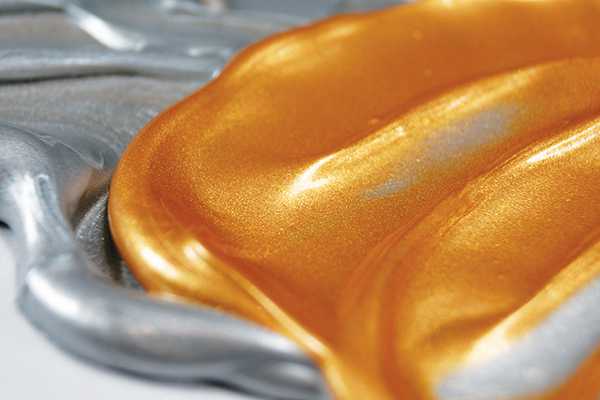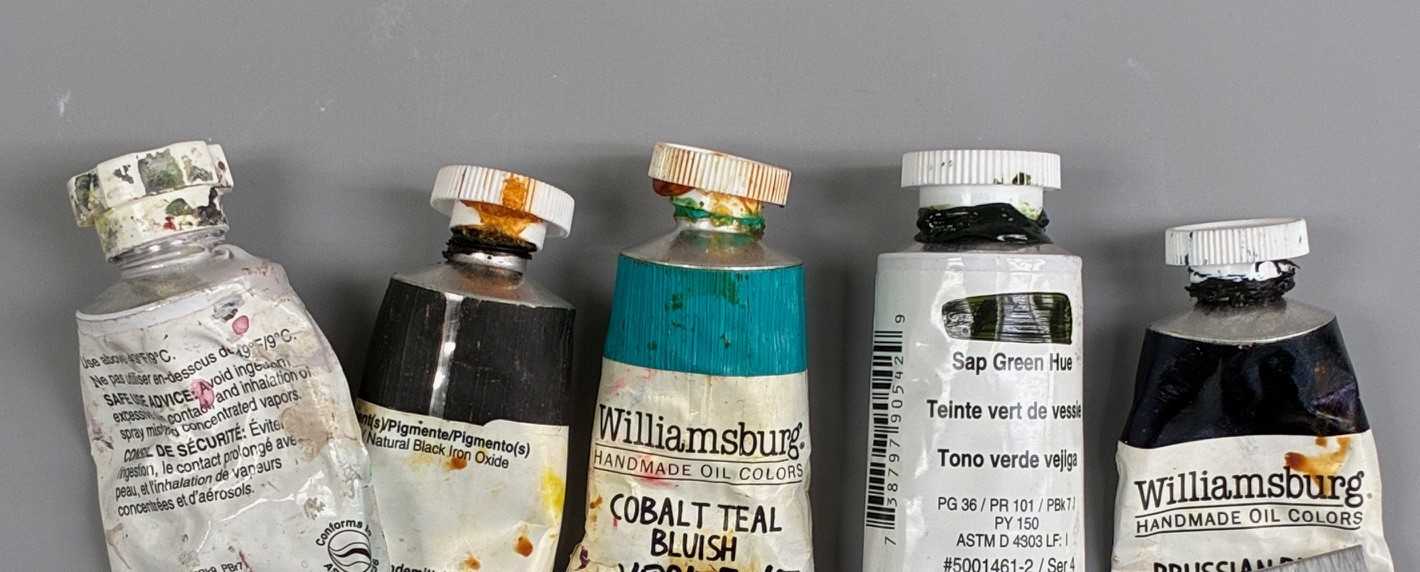INTERFERENCE AND IRIDESCENT ACRYLICS
| Interference Colors | Iridescent Colors | Metals & Natural Colors |
|---|---|---|
| GOLDEN produces 6 Interference Colors in Coarse and Fine sizes. The fine particles produce a more even sheen, while the coarse particles add more sparkle, especially on uneven surfaces. | GOLDEN Iridescents are offered in a variety of colors. Some of the 8 colors are offered in the coarse size, without appearing " glitter-like." | These reflective pigments are either actual metals, synthetic lamellar iron oxides or naturally produced mica flakes that are mined from the earth. |
| 1. Blue (Fine) & (Coarse) | 1. Bright Gold (Fine) | 1. Micaceous Iron Oxide |
| 2. Gold (Fine) & (Coarse) | 2. Bronze (Fine) | 2. Stainless Steel (Fine) & (Coarse) |
| 3. Green (Fine) & (Coarse) | 3. Copper (Fine) & (Coarse) | 3. Black Mica Flake (Small) |
| 4. Red (Fine) & (Coarse) | 4. Copper Lt (Fine) & (Coarse) | 4. Gold Mica Flake (Small) & (Large) |
| 5. Violet (Fine) | 5. Gold (Fine) & (Coarse) | 5. Pearl Mica Flake (Small) |
| 6. Gold Deep (Fine) | ||
| 7. Pearl (Fine) & (Coarse) | ||
| 8. Silver (Fine) |
PRODUCT DESCRIPTION
The GOLDEN Iridescent and Interference Colors achieve their reflective properties by synthetically reproducing several natural phenomena-the nacreous, or pearlescent, qualities found in fish scales or the dust of a butterfly's wing, and the shiny and reflective qualities found in certain metals and minerals.
"Coarse" Iridescent and Interference Colors are simply larger particle-size versions of our "Fine" Iridescent and Interference products. Coarse colors in the Iridescent line include Copper, Copper Light, Gold and Pearl. The Coarse Interference Colors are Blue, Gold, Green and Red.
All of GOLDEN's Iridescent Colors produce a luster quality by themselves, or when mixed with other colors and mediums. The GOLDEN line of Iridescents can be separated into 3 groups based on chemical composition.
Group I: These colors are derived from mica platelets. They are then coated with an extremely thin layer of titanium dioxide. Refraction and reflection of light at the titanium dioxide layers produces various colors and pearlescent effects. Group I pigments include:
- Interference Colors
- Iridescent Pearl (Coarse and Fine)
- Silver
Group II: These colors are also derived from mica platelets, but an iron oxide coating causes Group II pigments to possess hues in addition to pearlescent qualities. This group includes:
- Iridescent Gold (Coarse and Fine)
- Iridescent Copper and Copper Light (Coarse and Fine)
- Iridescent Bronze
Group III: A third group consists of reflective colorants that do not fit the above descriptions, including highly metallic pigments:
- Stainless Steel (Coarse & Fine)
- Micaceous Iron Oxide
- Mica Flakes (all varieties)
Luster Arises from Layers of Pigments:
The pigments in the first two groups (non-metallics) are composed of very thin, highly reflective and transparent platelets. Although the pigments themselves are transparent, the optical illusion of color is produced by the reflection of light between microscopic layers.
The Phenomenon of Light Interference:
The property at work in the Interference Colors is known as light interference, most commonly seen in the rainbow effect created by a thin layer of oil on a water surface. Thomas Young identified this phenomenon in 1801 in a series of investigations that were eventually instrumental in advancing the theory of the wave-like nature of light. Whenever light strikes a boundary between two materials of different densities, the light will either be reflected or refracted. If the refracted light encounters yet another boundary between materials of different densities, this light will again either be reflected or refracted. This process continues every time a new phase is encountered.
Light interference results from these concurrent multiple reflections and refractions of light. If the interference is constructive in nature, a strong color stimulus results. With Interference colors, a specific thickness of the titanium dioxide (TiO2) layer allows only a narrow spectrum of color to be reflected in phase, while all other reflected colors undergo destructive interference and are not observed. Since these pigments are transparent, a portion of the light will be transmitted and the resulting color will appear as the complement to the reflected color.
Excellent Weathering Resistance:
Mica is quite insoluble in strong acids or bases, is inherently lightfast, and remains unaffected by water. When combined with a 100% acrylic medium, mica yields very stable paints that offer excellent permanency.
Mica's chemical and UV resistance properties distinguish the Iridescent Mediums from most metal pigments, such as coppers, bronzes and even aluminum flakes. Metals have a tendency to rust or corrode as they continually oxidize over time. With the Iridescent colors, all components are already in the most stable state of oxidation, and there is no possibility for change resulting from further oxidizing reactions.
The metals that GOLDEN has chosen to offer are known to demonstrate remarkable durability. GOLDEN Stainless Steel (Coarse & Fine), which consists of extremely durable 316L grade stainless, is very resistant to salt spray and acid spotting, as well as alkaline cleaners or detergents. The Micaceous Iron Oxide, although highly reflective, is not in a metallic state but is already oxidized.
PRODUCT APPLICATION
Maintaining Bright Surfaces: The Options.
The highly reflective flake pigments used to produce Iridescent Mediums are extremely thin. These platelet pigments range from 1 to 2 microns in thickness and up to 90 microns in diameter for the Fine and 180 microns for the Coarse. Consider that the surface of an average flake of Iridescent Pearl could carry over 50,000 Carbon Black pigment particles placed side by side. Due to the larger particle size and the transparent nature of mica, iridescent colors tend to be less potent than other acrylic formulations.
Although no rule is absolute, some procedures for maintaining bright surfaces have proven their effectiveness. What follows is a brief review of some of the more successful approaches.
- To produce the brightest colors with the Interference line, add a very small amount of black - 1:100 or less. The black will strengthen the reflected color. Add more black if darker colors are required.
- To maintain the brightest possible effects with Iridescent Colors, avoid mixing them with opaque colors.
- Be aware that blends made with matte materials such as matte mediums and matte gels will also reduce iridescent qualities by scattering the light that hits the surface. Adding gloss materials, such as GOLDEN Gloss Gel, increases interference qualities by heightening reflectivity. The addition of Gloss Gels and Mediums also provides better spacing between pigment particles, maximizing the effectiveness of each reflective pigment.
- Overall, thicker applications will cloud the paint and weaken the intensity of the Interference Colors. Thinner applications increase the interference qualities. As the level of dilution increases, the pasty look disappears. Applying thin layers, whether by wash or glaze, effectively forces particles to lay flat with the large broad side facing the viewer. As more particle surfaces are exposed, the shimmer or luster increases.
Other Techniques and Considerations:
Since the Iridescent and Interference colors are relatively transparent, it is important to consider the impact of the base coat. By varying the color of the base coat, the overall color effect can be varied dramatically, especially when the Iridescent or Interference layer is applied transparently. For example, Interference Blue can be applied in glaze form over a light yellow or a dark red to yield some unique effects. Relatively transparent colors can be wet-blended into an Iridescent or Interference color producing other interesting results. Combining additional colors and Gloss Gels and Mediums can create some exciting glazes, in thin or thick films.
The important thing to remember about the Iridescent and Interference Colors is not to take them at face value. They can provide a range of colors and effects never before available, and many of their uses have yet to be discovered.
Disclaimer
The above information is based on research and testing done by Golden Artist Colors, Inc., and is provided as a basis for understanding the potential uses of the products mentioned. Due to the numerous variables in methods, materials and conditions of producing art, Golden Artist Colors, Inc. cannot be sure the product will be right for you. Therefore, we urge product users to test each application to ensure all individual project requirements are met. While we believe the above information is accurate, WE MAKE NO EXPRESS OR IMPLIED WARRANTIES OF MERCHANTABILITY OR FITNESS FOR A PARTICULAR PURPOSE, and we shall in no event be liable for any damages (indirect, consequential, or otherwise) that may occur as a result of a product application.



